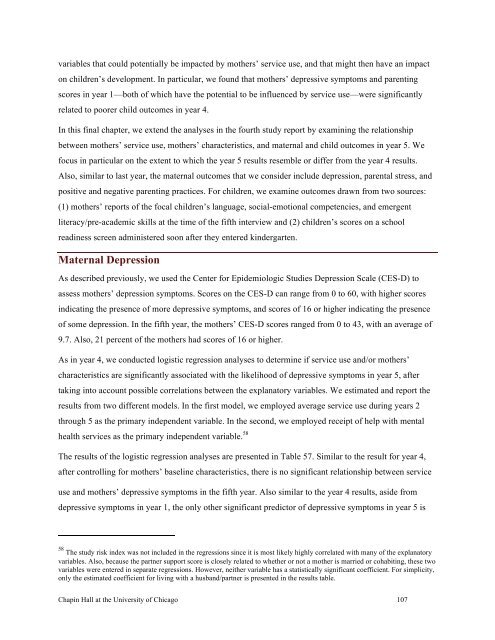2011 The Palm Beach County Family Study (Full Report)
2011 The Palm Beach County Family Study (Full Report)
2011 The Palm Beach County Family Study (Full Report)
- No tags were found...
You also want an ePaper? Increase the reach of your titles
YUMPU automatically turns print PDFs into web optimized ePapers that Google loves.
variables that could potentially be impacted by mothers’ service use, and that might then have an impacton children’s development. In particular, we found that mothers’ depressive symptoms and parentingscores in year 1—both of which have the potential to be influenced by service use—were significantlyrelated to poorer child outcomes in year 4.In this final chapter, we extend the analyses in the fourth study report by examining the relationshipbetween mothers’ service use, mothers’ characteristics, and maternal and child outcomes in year 5. Wefocus in particular on the extent to which the year 5 results resemble or differ from the year 4 results.Also, similar to last year, the maternal outcomes that we consider include depression, parental stress, andpositive and negative parenting practices. For children, we examine outcomes drawn from two sources:(1) mothers’ reports of the focal children’s language, social-emotional competencies, and emergentliteracy/pre-academic skills at the time of the fifth interview and (2) children’s scores on a schoolreadiness screen administered soon after they entered kindergarten.Maternal DepressionAs described previously, we used the Center for Epidemiologic Studies Depression Scale (CES-D) toassess mothers’ depression symptoms. Scores on the CES-D can range from 0 to 60, with higher scoresindicating the presence of more depressive symptoms, and scores of 16 or higher indicating the presenceof some depression. In the fifth year, the mothers’ CES-D scores ranged from 0 to 43, with an average of9.7. Also, 21 percent of the mothers had scores of 16 or higher.As in year 4, we conducted logistic regression analyses to determine if service use and/or mothers’characteristics are significantly associated with the likelihood of depressive symptoms in year 5, aftertaking into account possible correlations between the explanatory variables. We estimated and report theresults from two different models. In the first model, we employed average service use during years 2through 5 as the primary independent variable. In the second, we employed receipt of help with mentalhealth services as the primary independent variable. 58<strong>The</strong> results of the logistic regression analyses are presented in Table 57. Similar to the result for year 4,after controlling for mothers’ baseline characteristics, there is no significant relationship between serviceuse and mothers’ depressive symptoms in the fifth year. Also similar to the year 4 results, aside fromdepressive symptoms in year 1, the only other significant predictor of depressive symptoms in year 5 is58 <strong>The</strong> study risk index was not included in the regressions since it is most likely highly correlated with many of the explanatoryvariables. Also, because the partner support score is closely related to whether or not a mother is married or cohabiting, these twovariables were entered in separate regressions. However, neither variable has a statistically significant coefficient. For simplicity,only the estimated coefficient for living with a husband/partner is presented in the results table.Chapin Hall at the University of Chicago 107
















